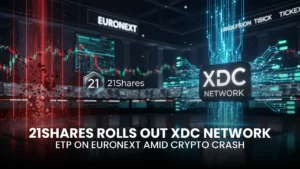Sui DEX Volume Hits ATH Amid Typus Exploit, SEC’s Green Signal to YLDS

Sui’s October story is a paradox investors know well: rapid growth alongside sharp risk. The network set a new all-time high for decentralized-exchange volume this month, a signal that on-chain activity and liquidity are expanding.
- Sui’s DEX Volume Hits An All-Time High
- A $3.4 Million Typus Oracle Exploit Resets Risk Perception
- Institutional Lean: SEC-Approved YLDS Token Comes To Sui Via Figure
- TVL Highs and Market Context
- For Investors: What Matters Now
- Sui October Snapshot
- Conclusion
- Frequently Asked Questions About Sui’s DEX ATH, Typus Exploit, and YLDS Tie-Up
- How does delegated proof of stake fit into Sui’s October news?
- Did the Typus exploit affect Sui’s base layer?
- Why is the YLDS integration important for Sui?
- Are DEX volumes sustainable after a spike?
- How should investors weigh TVL highs vs. security events?
- What practical steps reduce oracle risk for DeFi apps?
- Glossary of Key Terms
At the same time, Typus Finance, a Sui-based protocol, disclosed a $3.4 million oracle exploit that forced a full pause of its smart contracts. The bullish counterweight is an institutional-leaning development, as the SEC-approved YLDS token enters Sui through a partnership with Figure, with trading access via DeepBook.
For a Delegated Proof of Stake mechanism, where validator reputation and delegated capital shape throughput and stability, these touchpoints matter. They test whether a DPoS network can scale usage, improve security, and support regulated assets without losing pace.
This feature blends the news into one narrative. It outlines what changed in Sui’s market structure, why the Typus event is a risk reminder, and how a tokenized-yield instrument could pull more professional capital into a network that relies on elected validators. It also keeps the numbers honest, with source links and short quotes, and it returns to the core question for investors: Can Sui’s DPoS stack convert activity spikes into durable value while closing security gaps?
Sui’s DEX Volume Hits An All-Time High
Sui’s monthly DEX volume hit a new record in October, according to a Bitget news brief that flagged the surge as a milestone for the chain’s DeFi presence. The post highlights stronger user adoption and network momentum after a steady build-out of apps and liquidity venues on Sui.
Third-party feeds echoed the strength, with trackers noting Sui’s weekly DEX turnover above ten billion dollars in early October and a single-day print above one billion, a level that historically aligns with sustained user engagement rather than short-lived hype; similar readouts from KuCoin Flash.
While liquidity concentration also surfaced as a talking point. Community data shared on X suggested a high share of trades in SUI-USDT pairs during the run-up, which can amplify price discovery in the base asset but also heighten sensitivity to order-book depth and funding costs in volatile periods. One analyst post framed it candidly as a concentration risk to watch if volume normalizes in the coming weeks
Almost 65% of ALL sui dex volume in October is just suiUSDT – USDC pic.twitter.com/an9Qp4LPxn
— airtx (🥚,🥚) 🇦🇲 (@0xairtx) October 15, 2025
For a DPoS network like Sui, growing DEX activity tests validator performance and fee markets. By design, token holders delegate to validators who, in turn, process transactions and secure the ledger. In high-traffic conditions, throughput and finality shape user experience and developer confidence. If Sui converts peak activity into stickier usage, the fee base and staking rewards that underpin DPoS economics strengthen, which can reinforce validator incentives over time.
A $3.4 Million Typus Oracle Exploit Resets Risk Perception
Progress rarely shows up alone, and the Typus Finance exploit was the counter-narrative. On October 15, Typus reported that its TLP contract had been exploited through an oracle vulnerability, with losses of roughly $3.4 million. In response, the team paused all contracts to protect users and began working with Sui Foundation partners on an investigation. The market reaction was swift, with Typus’s token reportedly down more than 30 percent intraday.
ALSO READ: ARK Invest Rolls Out Space-Defense ETF in Europe as XDC Network Makes Headway in Dubai
The incident revived memories of the May 22 Cetus Protocol attack, when Sui’s largest liquidity venue suffered losses north of $200 million, according to multiple news reports (CoinDesk, Elliptic blog, BleepingComputer). Typus differs in scope, but the vector again centered on oracle design and authority checks, a recurring weak point across DeFi. One lesson is consistent: data-integrity layers must match throughput ambitions.
Sui’s consensus and execution pipeline is engineered for speed and parallelization, a trait that helped fuel the DEX surge. But security is multi-layered. Protocol teams that sit atop a DPoS base still need rigorous oracle governance, fail-safes, and circuit breakers. That balance between throughput and control is central to whether newer DeFi stacks can support institutional-grade flows without frequent interruptions.
“Approximately one hour ago, our TLP contract was exploited via an oracle vulnerability regarding a lack of authority checks.”
⚠️ URGENT SECURITY ANNOUNCEMENT ⚠️
Approximately one hour ago, our TLP contract was exploited via an oracle vulnerability regarding a lack of authority checks.
To protect all users, ALL Typus smart contracts have been immediately PAUSED.
We are actively investigating with…
— Typus Finance (@TypusFinance) October 15, 2025
Institutional Lean: SEC-Approved YLDS Token Comes To Sui Via Figure
On the other side of the ledger, Sui added a regulated-adjacent building block this week. Pintu reported that Figure Technology Solutions is bringing the SEC-approved YLDS token to Sui, with access routed through DeepBook. The token tracks yield from short-term Treasurys and repos, paying SOFR minus 35 basis points monthly.
The integration includes on- and off-ramp support and aims to funnel more compliant liquidity into the network. Pintu framed the near-term technical setup as a narrowing range with potential for a breakout if volumes persist, but the more durable angle is strategic: yield instruments with clear legal pathways can widen the funnel for institutions that need compliant rails.
This is the type of headline DPoS chains like Sui want. Delegated proof of stake (DPoS) relies on a competitive, well-capitalized validator set to deliver low-latency finality as applications scale. If tokenized cash equivalents grow on Sui, they can deepen on-chain liquidity and support a more complex market structure without overreliance on centralized venues. That loop, if it holds, helps staking economics and validator incentives, reinforcing DPoS with practical usage.
TVL Highs and Market Context
The network’s total value locked also reached a new all-time high in early October, a sign that capital is sticking around long enough to seed protocols and liquidity pools. A recent report highlighted Sui DeFi TVL around the $2.6 billion mark, even as price action has been choppy month to month. Elevated TVL does not immunize a chain from risk, but it does indicate breadth and depth that can cushion shocks and restore orderly trading after stress events.
ALSO READ: Is Cardano Back on Track: How Hydra and Exchange Staking Revived a 10% ADA Rally
The interplay is straightforward. Volume spikes plus TVL growth can tighten spreads and attract market-makers. Security lapses push in the other direction, raising risk premia and slowing new deployments. For investors, the mosaic is mixed, but the presence of regulated yield rails and the DPoS model’s emphasis on validator accountability provide a framework for improvement if protocol teams harden their oracle stacks.
For Investors: What Matters Now
First, separate base-layer traits from application-level risk. Sui’s DPoS design and consensus path, which historically drew on Narwhal and Bullshark and continues to optimize for fast finality, are not the same thing as a DeFi app’s oracle and permissioning choices. Validators can deliver throughput, but they do not fix a vault’s parameters or an oracle’s authority checks by default; background on Sui’s model via CoinShares guide.
Second, treat the YLDS integration as a directional signal. If regulated-style instruments grow inside DeepBook and similar venues, they can expand the base of repeat users, which stabilizes volumes and fees. That flies in formation with DPoS incentives, where sustained activity and gas fees feed staking rewards and keep validators invested in uptime and performance.
Third, monitor liquidity mix and pair concentration. The DEX ATH is constructive, but dependency on a few pairs can distort price discovery when trading conditions tighten. If concentration moderates and market depth broadens, it strengthens the thesis that Sui’s October was about genuine growth, not just a one-off rotation.
Fourth, demand better oracle hygiene. The fastest fix is not only auditing, but also layered defenses: authority checks, heartbeat thresholds, deviation caps, multiple sources, and emergency pause logic with transparency. The Cetus and Typus episodes will remain part of diligence checklists until the ecosystem demonstrates a track record of clean operations after upgrades and launches.
ALSO READ: Cardano Releases Hydra Node 1.0; Aims for Faster Transactions, Higher Throughput
Sui October Snapshot
| Metric or Event | What Happened | Why It Matters |
| Monthly DEX volume | New all-time high in October | Signals stronger on-chain activity and liquidity |
| Weekly turnover | > $10B in early October, with a $1.38B day | Confirms depth beyond a single venue |
| TVL | New ATH near $2.6B in October | Indicates stickier capital and broader app usage |
| Typus exploit | ~$3.4M lost via oracle issue, contracts paused | Highlights oracle governance risk |
| YLDS on Sui | SEC-approved YLDS token available via Figure and DeepBook | Brings regulated yield exposure on-chain |
Conclusion
Sui’s October delivers both validation and vigilance. The all-time high in DEX volume and a new pathway for regulated yield through YLDS strengthen the case that the network’s user base, liquidity, and institutional relevance are expanding. The Typus exploit is the caution flag, a pointed reminder that Oracle governance can undercut progress if not engineered for stress.
Delegated proof of stake can support this growth, aligning validator incentives with rising throughput and stable fee markets, but application-level controls must keep pace. If protocol teams shore up oracles and disclosures while the base layer continues to attract compliant assets and repeat users, Sui’s momentum has room to translate into durable value.
Frequently Asked Questions About Sui’s DEX ATH, Typus Exploit, and YLDS Tie-Up
How does delegated proof of stake fit into Sui’s October news?
Sui uses delegated proof of stake, where token holders delegate to validators who process transactions and share rewards. Higher activity and regulated-style assets can strengthen fee flows and validator incentives, but app-level security choices still require rigorous design and audits.
Did the Typus exploit affect Sui’s base layer?
There is no evidence of base-layer compromise. The reported issue was an Oracle vulnerability within Typus’s contracts. The team paused protocols and is working with partners on remediation.
Why is the YLDS integration important for Sui?
YLDS is an SEC-approved yield token backed by cash-equivalent assets. Its arrival on Sui via Figure and DeepBook may pull in more institutionally minded users who need compliant yield instruments, supporting deeper liquidity and recurring activity.
Are DEX volumes sustainable after a spike?
Sustainability depends on the breadth of pairs, market-maker commitments, and repeat user flows. October’s highs are constructive, but investors should watch for concentration risk and whether turnover holds as conditions normalize.
How should investors weigh TVL highs vs. security events?
Treat them as separate signals. Rising TVL and DEX volume point to adoption. Security incidents demand improved Oracle and contract controls. Both can evolve in parallel if teams harden systems while usage grows.
What practical steps reduce oracle risk for DeFi apps?
Multiple data sources, robust authority checks, deviation thresholds, latency guards, and transparent emergency pause logic. Regular audits before and after upgrades are critical. These controls complement, not replace, the base-layer assurances of a DPoS chain.
Glossary of Key Terms
- Delegated Proof of Stake (DPoS): A staking model where token holders delegate stake to validators who process transactions and earn rewards.
- Oracle: A data feed that supplies off-chain information to smart contracts.
- DEX Volume: Total value traded on decentralized exchanges over a period.
- TVL: Total value locked across DeFi protocols on a network.
- DeepBook: Sui’s native matching engine and liquidity layer for trading.
- SOFR: Secured Overnight Financing Rate, a broad measure of overnight U.S. Treasury repo costs.
- TLP: Token Liquidity Pool, a structure some protocols use to manage liquidity and yields.
- Pause Mechanism: Emergency control that stops contract functions during incidents.
- Validator: A node elected or selected to validate transactions and produce blocks in PoS or DPoS.
- On- and Off-Ramp: Services that convert between fiat and crypto assets.




